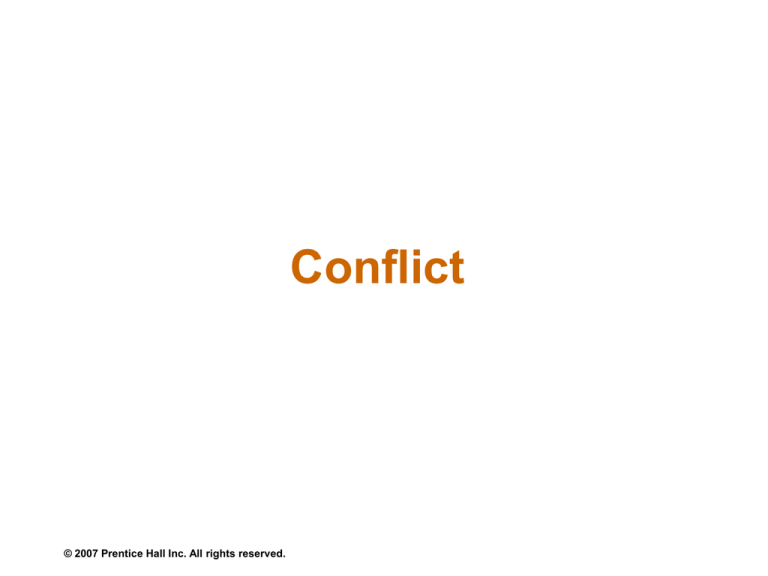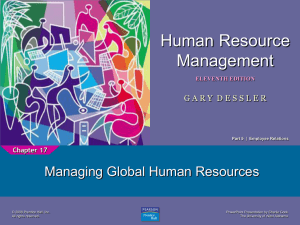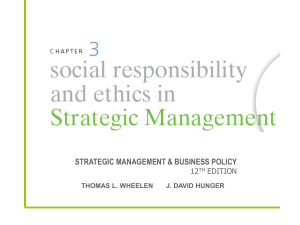
Conflict
© 2007 Prentice Hall Inc. All rights reserved.
Conflict
Conflict Defined
– A process that begins when one party perceives that
another party has negatively affected, or is about to
negatively affect, something that the first party cares
about.
• Is that point in an ongoing activity when an interaction
“crosses over” to become an interparty conflict.
– Encompasses a wide range of conflicts that people
experience in organizations
• Incompatibility of goals
• Differences over interpretations of facts
• Disagreements based on behavioral expectations
© 2007 Prentice Hall Inc. All rights reserved.
Transitions in Conflict Thought
Traditional View of Conflict
The belief that all conflict is harmful and must be
avoided.
Causes:
• Poor communication
• Lack of openness
• Failure to respond to
employee needs
© 2007 Prentice Hall Inc. All rights reserved.
Functional versus Dysfunctional Conflict
(Positive)
Functional Conflict
Conflict that supports the goals
of the group and improves its
performance.
Dysfunctional Conflict
(Negative)
© 2007 Prentice Hall Inc. All rights reserved.
Conflict that hinders
group performance.
Types of Conflict
Task Conflict
Conflicts over content and
goals of the work.
Relationship Conflict
Conflict based on
interpersonal relationships.
Process Conflict
Conflict over how work gets done.
© 2007 Prentice Hall Inc. All rights reserved.
The Conflict Process
E X H I B I T 15–1
© 2007 Prentice Hall Inc. All rights reserved.
Stage I: Potential Opposition or Incompatibility
Communication
– Semantic difficulties, misunderstandings, and “noise”
Structure
–
–
–
–
–
–
Size and specialization of jobs
Jurisdictional clarity/ambiguity
Member/goal incompatibility
Leadership styles (close or participative)
Reward systems (win-lose)
Dependence/interdependence of groups
Personal Variables
– Differing individual value systems
– Personality types
© 2007 Prentice Hall Inc. All rights reserved.
Stage II: Cognition and Personalization
Perceived Conflict
Felt Conflict
Awareness by one or more
parties of the existence of
conditions that create
opportunities for conflict to
arise.
Emotional involvement in a
conflict creating anxiety,
tenseness, frustration, or
hostility.
Conflict Definition
Negative Emotions
© 2007 Prentice Hall Inc. All rights reserved.
Positive Feelings
Stage III: Intentions
Intentions
Decisions to act in a given way.
Cooperativeness:
• Attempting to satisfy the other party’s
concerns.
Assertiveness:
• Attempting to satisfy one’s own concerns.
© 2007 Prentice Hall Inc. All rights reserved.
Dimensions of Conflict-Handling Intentions
Source: K. Thomas, “Conflict and Negotiation Processes in Organizations,” in M.D. Dunnette
and L.M. Hough (eds.), Handbook of Industrial and Organizational Psychology, 2nd ed., vol. 3
(Palo Alto, CA: Consulting Psychologists Press, 1992), p. 668. With permission.
© 2007 Prentice Hall Inc. All rights reserved.
E X H I B I T 15-2
Stage III: Intentions (cont’d)
Competing
A desire to satisfy one’s interests, regardless of the
impact on the other party to the conflict.
Collaborating
A situation in which the parties to a conflict each
desire to satisfy fully the concerns of all parties.
Avoiding
The desire to withdraw from or suppress a conflict.
© 2007 Prentice Hall Inc. All rights reserved.
Stage III: Intentions (cont’d)
Accommodating
The willingness of one party in a conflict to place the
opponent’s interests above his or her own.
Compromising
A situation in which each party to a conflict is
willing to give up something.
© 2007 Prentice Hall Inc. All rights reserved.
Stage IV: Behavior
Conflict Management
The use of resolution and stimulation techniques to
achieve the desired level of conflict.
© 2007 Prentice Hall Inc. All rights reserved.
Conflict-Intensity Continuum
Source: Based on S.P. Robbins, Managing Organizational Conflict: A Nontraditional Approach
(Upper Saddle River, NJ: Prentice Hall, 1974), pp. 93–97; and F. Glasi, “The Process of Conflict
Escalation and the Roles of Third Parties,” in G.B.J. Bomers and R. Peterson (eds.), Conflict
Management and Industrial Relations (Boston: Kluwer-Nijhoff, 1982), pp. 119–40.
© 2007 Prentice Hall Inc. All rights reserved.
E X H I B I T 15–3
Conflict Management Techniques
Conflict Resolution Techniques
• Problem solving
• Superordinate goals
• Expansion of resources
• Avoidance
• Smoothing
• Compromise
• Authoritative command
• Altering the human variable
• Altering the structural variables
Source: Based on S. P. Robbins,
Managing Organizational Conflict:
A Nontraditional Approach (Upper
Saddle River, NJ: Prentice Hall,
1974), pp. 59–89
E X H I B I T 15–4
© 2007 Prentice Hall Inc. All rights reserved.
Conflict Management Techniques
Conflict Resolution Techniques
• Communication
• Bringing in outsiders
• Restructuring the organization
• Appointing a devil’s advocate
Source: Based on S. P. Robbins, Managing Organizational Conflict: A Nontraditional
Approach (Upper Saddle River, NJ: Prentice Hall, 1974), pp. 59–89
© 2007 Prentice Hall Inc. All rights reserved.
E X H I B I T 15–4 (cont’d)
Stage V: Outcomes
Functional Outcomes from Conflict
– Increased group performance
– Improved quality of decisions
– Stimulation of creativity and innovation
– Encouragement of interest and curiosity
– Provision of a medium for problem-solving
– Creation of an environment for self-evaluation and
change
Creating Functional Conflict
– Reward dissent and punish conflict avoiders
© 2007 Prentice Hall Inc. All rights reserved.
Stage V: Outcomes
Dysfunctional Outcomes from Conflict
– Development of discontent
– Reduced group effectiveness
– Retarded communication
– Reduced group cohesiveness
– Infighting among group members overcomes group
goals
© 2007 Prentice Hall Inc. All rights reserved.




